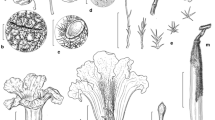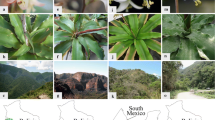Abstract
Senecio vulgaris L. (2n = 40) is suggested to be of autotetraploid origin fromS. vernalis Waldst. & Kit. (2n = 20). This conclusion is based on results obtained from experimental hybridisations and cytological observations, and the consideration of morphological affinities, patterns of geographical distribution and hybrid formation under natural conditions. The morphological differences between the two species are related to a difference in the breeding system. WhilstS. vernalis is self-incompatible,S. vulgaris is self-compatible and strongly self-pollinating. Equally, other self-pollinating taxa traditionally associated withS. vulgaris are shown to have evolved independently from outbreeding relatives. Within a narrow frame of relationship, annual weeds have evolved in different cytotaxonomic circumstances.
Similar content being viewed by others
References
Afzelius, K., 1924: Embryologische und zytologische Studien inSenecio und verwandten Gattungen. — Acta Horti Bergiani8, 123–219.
Alexander, J. C. M., 1975: Experimental taxonomy in some annual species ofSenecio from the Mediterranean area. — Ph.D. Thesis, University of Edinburgh.
—, 1979: Mediterranean species ofSenecio sectionSenecio andDelphinifolius. — Notes Royal Bot. Gard. Edinburgh37, 387–428.
Baker, H. G., 1967: The evolution of weedy taxa in theEupatorium microstemon aggregate. — Taxon16, 293–300.
Battandier, J. A., Trabut, L. C., 1888: Flore de l'Algerie. — Alger: A. Jourdan, Paris: F. Savy.
Black, J. M., 1957: Flora of South Australia4. Ed. 2. — Adelaide: K. M. Stevenson.
Boissier, 1875: Flora Orientalis3. — Genevae et Basileae: H. Georg.
Brenan, J. P. M., 1948:Senecio squalidus L. ×vulgaris L. — Rep. Bot. Soc. Exch. Club Br. Isl.13, 364.
Briggs, D., 1978: Genecological studies of salt tolerance in groundsel (Senecio vulgaris L.) with particular reference to roadside habitats. — New Phytol.81, 381–389.
Campbell, J. M., Abbott, R. J., 1976: Variability of outcrossing frequency inSenecio vulgaris L. — Heredity36, 267–274.
Candolle, A. P. de, 1838: Prodromus Systematis Naturalis Regni Vegetabilis6. — Paris.
Chater, A. O., Walters, S. M., 1976:Senecio. — InTutin, T. G. & al., (Eds.): Flora Europaea4. — Cambridge: Cambridge University Press.
Cheeseman, T. F., 1906: Manual of the New Zealand Flora. — Wellington: J. Mackay.
Clarke, C. B., 1876:Compositae Indicae. — Calcutta: Thacker, Spink & Co.
Crisp, P. C., 1972: Cytotaxonomic studies in the SectionAnnui ofSenecio. — Ph.D. Thesis, University of London.
Dostál, J., 1958: Klič k úplné květeně ČSR. — Praha.
Druce, G. C., 1886: The Flora of Oxfordshire. — Oxford and London: Parker.
Ellenberg, H., 1978: Vegetation Mitteleuropas mit den Alpen in ökologischer Sicht. 2. Aufl. — Stuttgart: E. Ulmer.
Favarger, C., 1967: Cytologie et distribution des plantes. — Biol. Rev.42, 163–206.
Feekes, W., 1936: De ontwikkeling van de natuurlijke vegetatie in de Wieringermeerpoller. — Amsterdam: Mulder & Zn.
Fiori, A., 1927: Nuova Flora Analitica D'Italia2. — Firenze: M. Ricci.
Gibbs, P. E., 1971: Studies on synthetic hybrids of British species ofSenecio. 1.S. viscosus L. ×S. vulgaris L. — Trans. Proc. Bot. Soc. Edinb.41, 213–218.
Godwin, H., 1975: The History of the British Flora. Ed. 2. — Cambridge: Cambridge University Press.
Grant, V., 1981: Plant speciation. Ed. 2. — Columbia: Columbia University Press.
Hálacsy, E. de, 1902: Conspectus Florae Graecae2. — Lipsiae: W. Engelmann.
Hance, H. F., 1868: Three new ChineseAsteraceae. — J. Bot.6, 173–175.
Harland, S. L., 1954: The genusSenecio as a subject for cytogenetical investigation. — Proc. Bot. Soc. Brit. Isl.1, 256–257.
Harvey, W. H., Sonder, O. W., 1865: Flora Capensis3. — Dublin: Hodges Smith & Co.
Hegi, G., 1928: Illustrierte Flora von Mittel-Europa6(2). — München: J. F. Lehmann.
Hoffmann, O., 1894:Compositae. — InEngler, A., Prantl, K., (Eds.): Die natürlichen Pflanzenfamilien4(5). — Leipzig: W. Engelmann.
Hooker, J. D., 1881: Flora of British India3. — London: L. Reeve & Co.
Hylander, N., 1955: List of the plants of N. W. Europe. — Lund: C. W. K. Gleerup.
Ingram, R., 1977: Synthesis of the hybridSenecio squalidus L. ×S. vulgaris f.radiatus Hegi. — Heredity39, 171–173.
—, 1978: The genomic relationship ofSenecio squalidus L. andSenecio vulgaris L. and the significance of genomic balance in their hybridS. ×baxteri Druce. — Heredity40, 459–462.
—, 1980: New evidence concerning the origin of inland radiate groundsel,S. vulgaris L. var.hibernicus Syme. — New Phytol.84, 543–546.
Jacobasch, E., 1894:S. vulgaris L. undS. vernalis W. K. sind nur Endglieder zweier Entwicklungsreihen einer Urform. — Verh. Bot. Ver. Prov. Brandenb.36, 78–87.
Jeffrey, C., 1979: Generic and sectional limits inSenecio (Compositae) II. Evaluation of some recent studies. — Kew Bull.34, 49–58.
—, 1977: Generic and sectional limits inSenecio (Compositae) I. Progress report. — Kew Bull.32, 47–67.
Kent, D. H., 1956:Senecio squalidus L. in the British Isles. 1. Early records (to 1877). — Proc. Bot. Soc. Br. Isl.2, 115–118.
Kunkel, G., 1972: Enumeracion de las plantas vasculares de Gran Canaria. — Las Palmas: Monographiae Biologicae Canariensis3.
Lojacono, M., 1903: Flora Sicula2 (1). — Palermo: L. Pedone.
Lange, J., 1886: Haandbog i den danske Flora. — Kjobenhavn: C. A. Reitzel.
Leslie, A. C., 1978:Senecio squalidus L. ×S. vulgaris L. in Cambridgeshire. — Watsonia12, 155–156.
Lindmann, C. A. M., 1926: Svensk Phanerogamenflora. — Stockholm: P. A. Nordstedt & Söners.
Maire, R., 1923: Contributions à l'étude de la flore de l'Afrique du Nord. — Bull. Soc. Hist. Nat. Afr. Nord14, 118–159.
Marshall, D. F., Abbott, R. J., 1982: Polymorphism for outcrossing frequency at the ray floret locus inSenecio vulgaris L. I. Evidence. — Heredity48, 227–235.
Mullenders, W., 1967: Flore de la Belgique, du Nord de la France et des regions voisines. — Liège: Desoer.
Ooststroom, S. J. van, 1973: Flora van Nederland. Ed. 7. — Groningen: Wolters-Noordhoff.
Perring, F. H., Sell, P. D., 1968: Critical Supplement to the Atlas of the British Flora. — London: T. Nelson & Sons.
Rogerson, C. T., 1978: North American Flora2(10). — New York Botanical Garden.
Rosser, E. M., 1955: A new british species ofSenecio. — Watsonia3, 228–232.
Schinz, H., Keller, R., 1914: Flora der Schweiz2. 3. Aufl. — Zürich: A. Raustein.
Sennen, E. C., 1921: À propos de quelque plantes rare. — Bull. Soc. Bot. Fr.68, 402–408.
—, 1925: La garrigue du littoral, depuis Montpellier jusqu'à Sagunto. — Bull. Soc. Bot. Fr.72, 92–114.
Stace, C. A., 1977: The origin of radiateSenecio vulgaris L. — Heredity39, 383–388.
Stebbins, G. L., 1971: Chromosomal Evolution in Higher Plants. — London: E. Arnold.
Sylven, N., 1907: Zwei im Bergianischen Garten im Sommer 1906 gefundeneSenecio-Hybriden. — Acta Horti Bergiani4 (3), 1–8.
Szafer, W., 1953: Rosliny Polskie. — Warszawa.
Trow, A. H., 1912: On the inheritance of certain characters in the Common Groundsel —Senecio vulgaris L. — and its segregates. — J. Genet.2, 239–276.
Uechtritz, R. von, 1874: Floristische Bemerkungen. — Öst. Bot. Z.24, 242.
Weimarck, H., 1963: Skånes Flora. — Lund: Corona AB.
Weir, J., Ingram, R., 1980: Ray morphology and cytological aspects ofS. cambrensis Rosser. — New Phytol.86, 237–241.
Zabel, H., 1869: Kleine botanische Mitteilungen. 1. ZweiSenecio-Varietäten. — Verh. Bot. Ver. Prov. Brandenb.11, 138–140.
Author information
Authors and Affiliations
Rights and permissions
About this article
Cite this article
Kadereit, J.W. The origin ofSenecio vulgaris (Asteraceae). Pl Syst Evol 145, 135–153 (1984). https://doi.org/10.1007/BF00984036
Received:
Issue Date:
DOI: https://doi.org/10.1007/BF00984036




